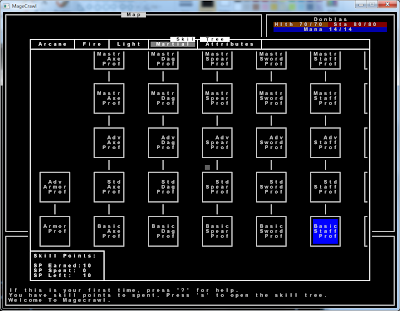So I've spent this week doing "research" on what next lies in store for Magecrawl.
The first thing I've realized is I now have a good "family tree" for Magecrawl. While Magecrawl isn't developed enough for
Crawl to consider it a legitimize offspring, it provides much of the inspiration and root ideas. Things like tactical gameplay, high difficulty, removal of any "grinding" gameplay, and a crazy good auto-explore are all things I aspire to have.
Borderlands takes the role of the crazy uncle that rubs of a little bit. It provides such a varied equipment set that playing the game a second (and third) playthrough is fun and interesting.
Diablo can be considered one of the grandfather figures. It to me was one of the great dungeon delve games of my youth.
My serious hope is that is the last "iteration" in the series to build up a game engine. Tasks I want to finish to put me in a great place include:
- 55 open issues in my bug database, mostly minor and a few major features. Some major ones include:
- Better monster AI using sounds or smell
- Status effects from various schools
- Better use of spell effect areas to differentiate the schools
- "Typed" damage, just as fire or physical. Resistances to various damage types.
- Refactor the GameEngine library into multiple separate libraries, pulling out:
- Monster creation/behavior
- Status effects
- Map creation
- Some form of basic integration testing for common operations.
- Some form of "arena" for testing the weights of various skill tree nodes, along with the possibility of an awesome screen saver.
So yeah, that's a lot of work. I'm in no hurry to start working a masses of content for a "slice" game, so if it takes me multiple months, it isn't the end of the world.
While I'm still planning on working on Magecrawl (a lot), I feel like I'm in a good place to open up development to others if they are interested. Developing on Magecrawl offers:
- A relatively clean/nice C# codebase
- Licensed BSD
- Works on Windows/Mac/Linux, development is possible on any platform
- The possibility to implement high level functionality on a working game, as opposed to starting at square one with an @ walking around the screen (not that there is anything wrong with that)
If this sounds interesting, feel free to contact me at chris dot hamons at gmail dot com.
One last thing, I re-realized how awesome
Ascii Dreams is. The "Designing a Magic System" serious of
articles and the
follow ups should be on the required reading list for any future roguelike developer (or game developer in general). I wish he updated it more often these days, the content is golden.







